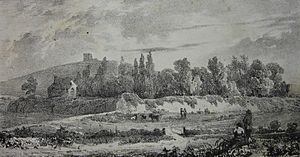Chateau des Marais, Guernsey facts for kids
The Chateau des Marais is a special old castle in Saint Sampson, Guernsey. People often call it Ivy Castle because of all the ivy that used to grow on its walls. It's a very old castle with a moat (a ditch filled with water) that was built even before the 1100s!
Contents
History of Ivy Castle
Long, long ago, between 3,500 and 1,500 BC, people from the Stone Age (Neolithic settlers) used the hill where the castle now stands. We know this because archaeologists have found old tools and items there.
The Middle Ages (1100s - 1400s)
Records show that a strong building was already here in 1170. Later, in 1244 and 1292, people still talked about it as an old fort.
In the 1200s, the castle was changed into a Motte-and-bailey castle. This means the top of the hill (the "motte") was made flat. A moat was dug around it, and the dirt from the moat was used to build up the inner and outer walls. An outer wall was also built in the marshy area. This marsh was drained to make the middle of the fort dry.
People believe there was once a chapel inside the castle, but its exact spot has never been found. Old papers from 1330 mention a chaplain (a priest) who worked at the castle.
The Ivy Castle became less important after Castle Cornet was built in the mid-1200s. Castle Cornet was a newer, stronger fort. The Chateau des Marais might have then been used as a safe place for people and animals during attacks.
Early Modern Times (1600s - 1700s)
Even in the early 1600s, people still remembered what the castle was for. Royal officials described it as a "very ruined and decayed castle." They said it was "long ago used for the Mansion or seat of the Captains and Governors of this isle."
In 1726, a botanist named Thomas Knowlton visited the island. He came to study the Guernsey Lily flower. He saw the castle and wrote that it was "formerly a strong place, but now is nothing but a heap of ruins and walls covered with ivy." He thought the ivy was why it got its nickname.
Later Modern Times (1800s - Today)
The castle was made strong again during the Napoleonic Wars (around the early 1800s). The stone fort you see today was built then. The moat was dug out again. Steps were added for soldiers to fire muskets from. The inner area was walled, and a place to store gunpowder (a powder magazine) was built. Other buildings, like barracks for soldiers, were probably built too.
After the wars, the castle fell into disrepair again. It became the Governor's garden and even had pigsties! A factory that made alcohol from potatoes was also set up there in 1827, but it burned down in 1832.
During the German occupation of Guernsey in World War II, the fort was used for defence. A special command bunker was built inside its walls. Machine gun posts and trenches for communication were also added.
Later, the land changed hands from the War Department to the States of Guernsey, who own it now.
Castle Design
The Chateau des Marais is built on a small rocky hill. This hill was once surrounded by a wide marshy area called Marais d’Orgueil. The castle has a moat around it. The outer stone wall is not very strong and was built simply. It has an inner and outer area (bailey) that were built in the 1200s.
The walls you see today were mostly built when the castle was made strong again in the 1700s.
What Archaeology Tells Us
In the 1970s, archaeologists dug up the site. They found old jewellery, pottery, and flint tools. These finds show that people lived in this area at least since the late Stone Age (Neolithic period), or even earlier. There are also Neolithic standing stones nearby.
Archaeologists found little evidence from the Iron Age.
From the 1200s, evidence shows that the area was burned to clear it. Builders then marked out the site with standing stones. They cut turf (grass and soil) to make an embankment, which was then topped with clay and granite.
Visiting Ivy Castle Today
The Chateau des Marais is open for everyone to visit! You can get there by walking along footpaths from Ivy Castle Lane or Victoria Avenue. There is also parking available off Sir John Leale Avenue, which is near Victoria Avenue.
Protection
The entire Chateau des Marais was officially listed as a Protected Monument on March 26, 1938. This means it is a very important historical site that must be preserved.
Ivy Castle in Art
- Francis Grose (1731-1791) made a copper engraving of "Marsh Castle" in 1777. It was published in his book, The Antiquities of England and Wales.
- Joshua Gosselin (1739–1813) created a pen, ink, and watercolour drawing called "Château des Marais Guernsey" in 1793.


